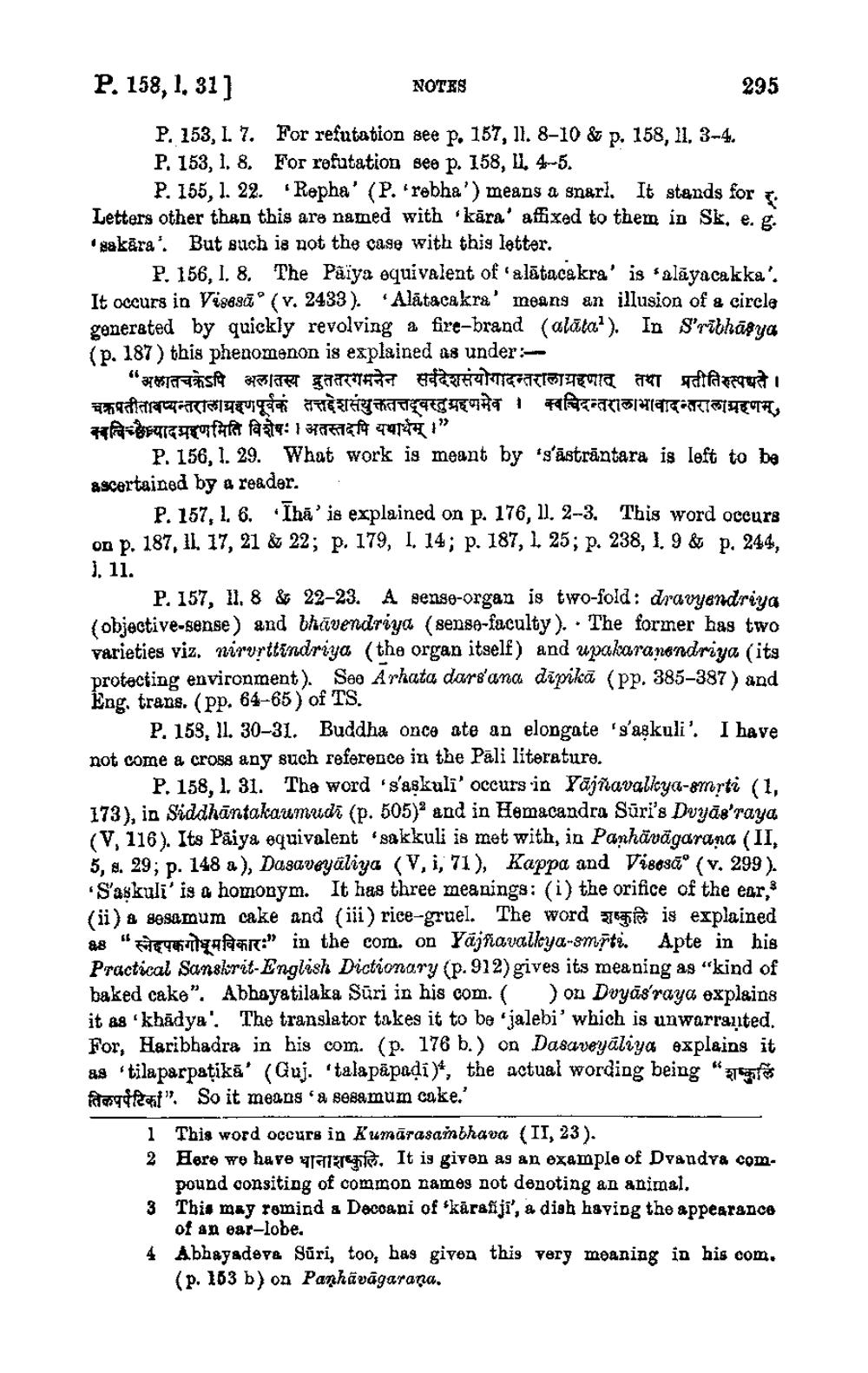________________
P. 158, 1, 31]
NOTES
295
P. 153, 1. 7. For refutation see p. 157, 11. 8–10 & p. 158, 11, 3-4. P. 153, 1. 8. For refutation see p. 158, 11. 4-5.
P. 155, 1. 22. "Repha' (P. robha') means a snarl. It stands for Letters other than this are named with "kāra' affixed to them in Sk, eg sakāra'. But such is not the case with this letter.
P. 156, 1. 8. The Pâiya equivalent of 'alātacakra' is Salāyacakka'. It occurs in Visesão (v. 2433). 'Alātacakra' means an illusion of a circle generated by quickly revolving a fire-brand (alāta"). In Sribhāgya (p. 187) this phenomenon is explained as under:
"अलातचक्रेऽपि अलातस्य द्रुततरगमनेन सर्वदेशसंयोगादन्तरालाग्रहणात् तथा प्रतीतिरुत्पते । चक्रपतीतावप्यन्तरालाग्रहणपूर्वकं तत्तदेशसंयुक्ततत्तद्वस्तुग्रहणमेव । क्वचिदन्तरालामावादन्तरालाग्रहणम्, स्वविध्यादग्रहणमिति विशेषः । अतस्तदपि यथार्थम् ।"
P. 156, 1. 29. What work is meant by g'āstrāntara is left to be ascertained by a reader. .
P. 157, 1. 6. Īhā' is explained on p. 176, 11. 2-3. This word occurs on p. 187, 11, 17, 21 & 22; p. 179, I. 14; p. 187, 1. 25; p. 238, 1.9 & p. 244, 1, 11.
P. 157, 11, 8 & 22-23. A senge-organ is two-fold: dravyandriya (objective-sense) and bhavendriya (sensa-faculty). . The former has two varieties viz, nirorttendriya (the organ itself) and upakaranendriya (its protecting environment). See Arkata dars'ana dipikā (pp. 385-387) and Eng. trans. (pp. 64-65 ) of TS.
P. 153, 11. 30-31. Buddha once ate an elongate 's'agkuli'. I have not come a cross any such reference in the Pali literature.
P. 158, 1. 31. The word "s'askuli' occurs in Yājñavallya-smrti (1, 173), in Siddhāntakaumudi (p. 505) and in Hemacandra Sūri's Dvyās'raya (V, 116). Its Päiya equivalent sakkuli is met with, in Panhāvāgarana (II, 5, d. 29, p. 148 a), Dasaveyaliya (V, i, 71), Kappa and Visosa" (v. 299).
S'askuli' is a homonym. It has three meanings: (i) the orifice of the ear. (ii) a sesamum cake and (iii) rice-gruel. The word 35 is explained 88 "Fenernyataan:" in the com. on Yājñavalkya-smrti. Apte in his Practical Sanskrit-English Dictionary (p.912) gives its meaning as "kind of
aked cake". Abhayatilaka Sūri in his com. ( ) on Dvyās'raya explains it as khădya'. The translator takes it to be 'jalebi' which is unwarranted. For, Haribhadra in his com. (p. 176 b.) on Dasaveyaliya explains it as "tilaparpatikā' (Guj. 'talapāpadi)*, the actual wording being " tes faragdfacat". So it means 'a sesamum cake.'
1 This word occurs in Kumārasambhava (II, 23). 2 Here we have ETRO. It is given as an example of Dvandya com.
pound consiting of common names not denoting an animal. 3 This may remind a Dacoapi of skārafiji', a dish having the appearance
of an ear-lobe. 4 Abhayaders Sūri, too, has given this very moaning in his com.
(p. 103 b) on Paphāvāgarana.




